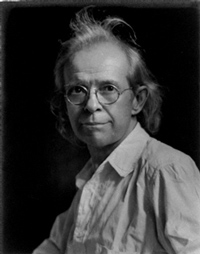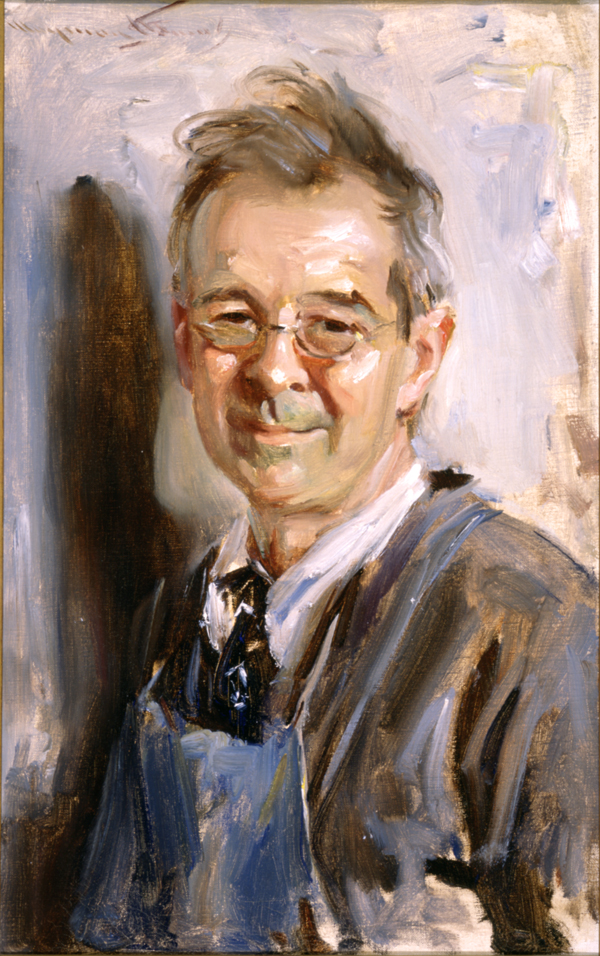
Queer Places:
726 St. Peter Street, New Orleans
Rose Hill Cemetery
New Goshen, Vigo County, Indiana, USA
 Joseph
Woodson “Pops” Whitesell (February 11, 1876 – February 18, 1958) was a
universally popular figure among his neighbors in the French Quarter, high
society clientele, celebrities from the world of arts and letters, and
fellow photographers. Among his famous portrait subjects; Wayman Adams,
Sherwood Anderson,
Sinclair Lewis,
Lyle Saxon, Erle Stanley Gardner
(who put Pops in two of his novels as “Gramps Wiggins”). His fame led to a
one man exhibition at Smithsonian Institution of 58 of his photographs in
1946. Pops never married.
Joseph
Woodson “Pops” Whitesell (February 11, 1876 – February 18, 1958) was a
universally popular figure among his neighbors in the French Quarter, high
society clientele, celebrities from the world of arts and letters, and
fellow photographers. Among his famous portrait subjects; Wayman Adams,
Sherwood Anderson,
Sinclair Lewis,
Lyle Saxon, Erle Stanley Gardner
(who put Pops in two of his novels as “Gramps Wiggins”). His fame led to a
one man exhibition at Smithsonian Institution of 58 of his photographs in
1946. Pops never married.
Joseph Woodson “Pops” Whitesell was born in Libertyville, Indiana, on
February 11, 1876, the son of Simon Bruce Whitesell (1853-1923) and Alice
Chunn (1855-1936). He moved to New Orleans in 1918 and made the city his
permanent home. Whitesell’s photography achieved international recognition
in professional salon exhibitions. In 1947, he was the ninth most
exhibited salon photographer in the world. His studio at 726 St. Peter Street, in the
outbuilding behind what would become Preservation Hall, was always alive
with visitors, conversation, and photographic activities.
After establishing his French Quarter studio in 1921, Whitesell enjoyed
a successful practice concentrating on portraiture. His sitters included
debutantes, Mardi Gras royalty, and wedding parties. Whitesell was not
only adept in the lighting of a single portrait subject or character
study, he was also acclaimed for staging and effectively lighting groups
of eight people or more within the confines of the studio. It is for such
efforts that his work was exhibited throughout the world, and acquired by
museums, such as Washington, D.C.’s Smithsonian Institution, for permanent
collections. Whitesell’s peer recognition was underscored by his
memberships in the Photographic Society of America (where he was
designated a Fellow), the Professional Photographers Association
(achieving the pinnacle title Master Photographer), and Great Britain’s
Royal Photographic Society. In 1946 the Smithsonian Institution mounted an
exhibition of fifty-eight of his prints.
Once his mature style of carefully lit portraiture was established,
Whitesell maintained it until his death. Softly focused subjects, richly
toned prints, and retouching that flattered his sitters were techniques
that he employed even on the streets of the French Quarter. In addition to
traditional silver-based prints, Whitesell occasionally produced bromoil
transfer prints. The basis for such work always originated with a
photograph, but the final product had the appearance of a lithograph or
aquatint engraving. His image of the Arsenal, a building adjacent to
the Cabildo on St. Peter Street in the French Quarter, is an example of
this technique.

Portrait of Joseph "Pops" Woodson. Adams, Wayman (artist)

Portrait of Pops Whitesell by Xavier Gonzalez. Gonzalez, Xavier (Artist)
In the early 1950s, an infection in his leg that went untreated for too
long resulted in the limb’s amputation. Though confined to a wheelchair,
Whitesell continued to print photographs, but at a much diminished pace.
Daniel S. Leyrer — a photographer whose studio and apartment were in the
same building as Whitesell’s — along with friends and admirers, assisted
and comforted Whitesell until his death on February 18, 1958, a week
following his eighty-second birthday. His remains were sent to Indiana for
burial. What remained of Whitesell’s negative archive was donated to
Tulane University in New Orleans in 1978.
In 1926 Pelican Bookshop Press, New Orleans, published "William Spratling and William Faulkner, Sherwood Anderson and Other Famous Creoles: A Gallery of Contemporary New Orleans",
issued in 250 copies. The “Famous Creoles” (with ages in 1926) were
- Conrad Albrizio, 27, New York-born, serious artist, Spratling’s neighbor, Arts and Crafts Club stalwart
- Sherwood Anderson, 50, “Lion of the Latin Quarter,” eminence gris, generous to respectful younger writers
(LGBTQ friendly)
- Marc Antony and Lucille Godchaux Antony, both 28, Love-match between heiress and lower-middle-class boy, local artists
- Hamilton “Ham” Basso, 22, Star-struck recent Tulane grad, aspiring writer, good dancer
(LGBTQ friendly)
- Charles “Uncle Charlie” Bein, 35, Director of Arts and Crafts Club’s art school; lived with mother, sister, and aunt
(GAY)
- Frans Blom, 33, Danish archeologist of Maya, Tulane professor, colorful resident of Quarter
- Roark Bradford, 30, Newspaperman, jokester, hit pay dirt with Negro dialect stories
- Nathaniel Cortlandt Curtis, 45, Tulane architecture professor, preservationist, recorded old buildings
- Albert Bledsoe Dinwiddie, 55, President of Tulane, Presbyterian
- Marian Draper, 20, Ziegfeld Follies alum, Tulane cheerleader, prize-winning architecture student
- Caroline “Carrie” Wogan Durieux, 30, Genuine Creole, talented artist living in Cuba and Mexico, painted by
Rivera
- William “Bill” Faulkner, 29, Needs no introduction, but wrote the one to
Famous Creoles (LGBTQ friendly)
- Flo Field, 50, French Quarter guide, ex-journalist, sometime playwright, single mother
- Louis Andrews Fischer, 25, Gender-bending Mardi Gras designer, named for her father
(LGBTQ friendly)
- Meigs O. Frost, 44, Reporter’s reporter; lived in Quarter; covered crime, revolutions, and arts
- Samuel Louis “Sam” Gilmore, 27, Greenery-yallery poet and playwright, from prominent family
(GAY)
- Moise Goldstein, 44, Versatile and successful architect, preservationist, active in Arts and Crafts Club
- Weeks Hall, 32, Master of and slave to Shadows-on-the-Teche plantation, painter, deeply strange
(GAY)
- Ronald Hargrave, 44, Painter from Illinois formerly active in Quarter art scene, relocated to Majorca
- R. Emmet Kennedy, 49, Working-class Irish boy, collected and performed Negro songs and stories
- Grace King, 74, Grande dame of local color literature and no-fault history,
salonnière
- Alberta Kinsey, 51, Quaker spinster, Quarter pioneer, indefatigable painter of courtyards
- Richard R. Kirk, 49, Tulane English professor and poet, loyal Michigan Wolverine alumnus
- Oliver La Farge, 25, New England Brahmin, Tulane anthropologist and fiction-writer, liked a party
- Harold Levy, 32, Musician who ran family’s box factory, knew everybody, turned up everywhere
- Lillian Friend Marcus, 35, Young widow from wealthy family, angel and manager of
Double Dealer (LGBTQ friendly)
- John “Jack” McClure, 33, Poet, newspaper columnist and reviewer,
Double Dealer editor,
bookshop owner
- Virginia Parker Nagle, 29, Promising artist, governor’s niece, Arts and Crafts Club teacher
- Louise Jonas “Mother” Nixon, 70, A founder of Le Petit Theatre and its president-for-life, well-connected widow
- William C. “Cicero” Odiorne, 45, Louche photographer, Famous Creoles’ Paris contact
(GAY)
- Frederick “Freddie” Oechsner, 24, Recent Tulane graduate, ambitious cub reporter, amateur actor
- Genevieve “Jenny” Pitot, 25, Old-family Creole, classical pianist living in New York, party girl
-
Lyle Saxon, 35, Journalist, raconteur, bon vivant, host, preservationist, bachelor
(GAY)
- Helen Pitkin Schertz, 56, Clubwoman, civic activist, French Quarter guide, writer, harpist
- Natalie Scott, 36, Journalist, equestrian, real-estate investor, Junior Leaguer, social organizer
(LGBTQ friendly)
- William “Bill” Spratling, 25, Famous Creoles
illustrator, Tulane teacher, lynchpin of Quarter social life (GAY)
- Keith Temple, 27, Australian editorial cartoonist, artist, sometimes pretended to be a bishop
- Fanny Craig Ventadour, 29, Painter, Arts and Crafts Club regular, lately married and living in France
- Elizebeth Werlein, 39, Suffragette with colorful past, crusading preservationist, businessman’s widow
- Joseph Woodson “Pops” Whitesell, 50, Photographic jack-of-all-trades, French Quarter eccentric, inventor
(GAY)
- Daniel “Dan” Whitney, 32, Arts and Crafts Club teacher, married (two) students, beauty pageant judge
- Ellsworth Woodward, 65, Artistic elder statesman, old-fashioned founder of Newcomb art department
My published books:


BACK TO HOME PAGE



 Joseph
Woodson “Pops” Whitesell (February 11, 1876 – February 18, 1958) was a
universally popular figure among his neighbors in the French Quarter, high
society clientele, celebrities from the world of arts and letters, and
fellow photographers. Among his famous portrait subjects; Wayman Adams,
Sherwood Anderson,
Sinclair Lewis,
Lyle Saxon, Erle Stanley Gardner
(who put Pops in two of his novels as “Gramps Wiggins”). His fame led to a
one man exhibition at Smithsonian Institution of 58 of his photographs in
1946. Pops never married.
Joseph
Woodson “Pops” Whitesell (February 11, 1876 – February 18, 1958) was a
universally popular figure among his neighbors in the French Quarter, high
society clientele, celebrities from the world of arts and letters, and
fellow photographers. Among his famous portrait subjects; Wayman Adams,
Sherwood Anderson,
Sinclair Lewis,
Lyle Saxon, Erle Stanley Gardner
(who put Pops in two of his novels as “Gramps Wiggins”). His fame led to a
one man exhibition at Smithsonian Institution of 58 of his photographs in
1946. Pops never married. 
